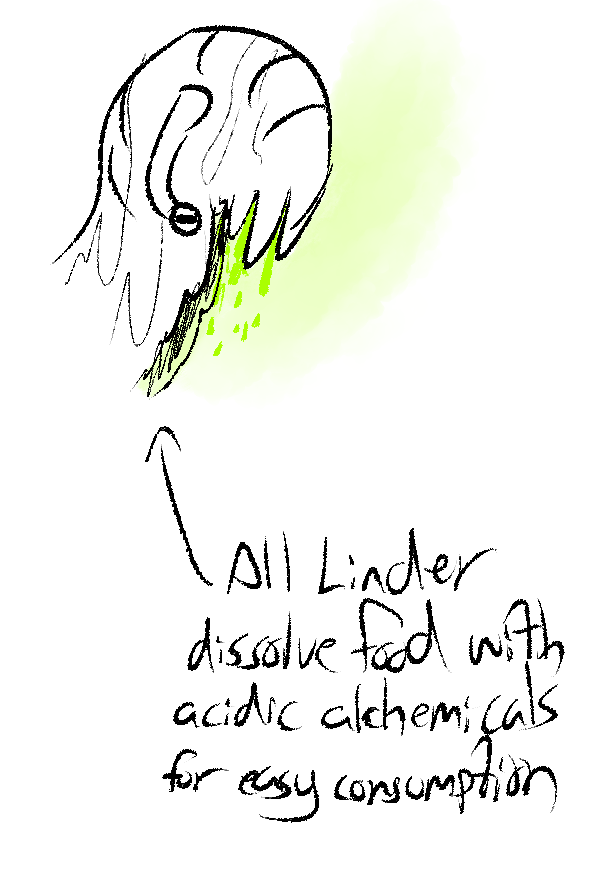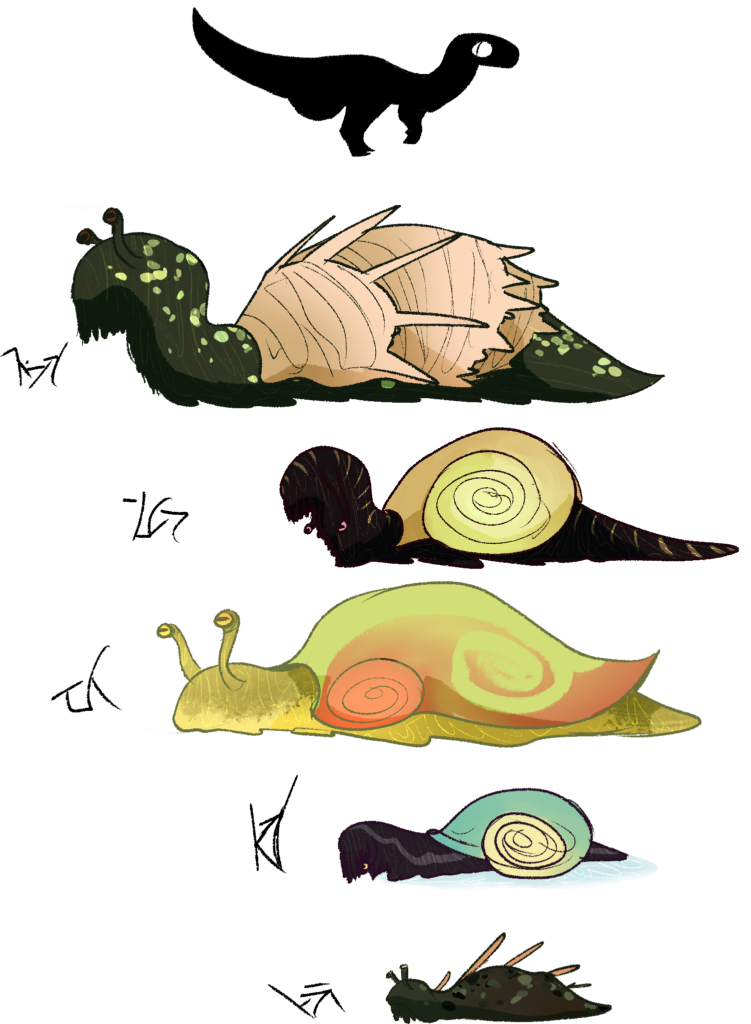
Lindir (Leen-deer) or Lind Singular
Cattle, specifically cows and oxen were equally transformed into the giant snails from the influence of the Pulse.
Lindir have a long prepulse history however as a prepulse õndemic creature, being made by the sivilão as an animal for meat, with both their eggs and flesh being used to feed the drekir of prejãrsta Õndem for thousands of years prior to The Pulse, and after in the many remnant õfuthar of the dragonscape. However thanks to the chaos allowing many sivilão lindir to rewild and the transformation of cattle in the americas into lindir they are also a common species to find both in the Americas and in many other planar. Though they are particularly common in the planar of America and Agõrl.
Anatomy, Biology, Breeds and Diets.
Lindir are massive snails (and sometimes slugs), often complete with large shells and mucusy bodies. The nature of their biology does require that they stay moist and so they will only be found wherever there is a lot of water. Ponds, rivers, coasts, lakes, wetlands, etc. are common places to find lindir thanks to their high water needs.

As for diets, lindir tend to fall into two categories of diet. Breeds like the temperate, alpine and arid lindir are obligate herbivores that will graze on most any plant they can reach but particularly shrubs, grasses, and reeds. Whereas Tropical and Arctic Lindir are far more omnivoric, bottom feeders of land and water that will dissolve and eat whatever they happen to slubber and slobber over.
But all lindir utilize an acidic alchemical to break down whatever it is they are eating and can secrete it from the ventral (bottom) side of their body.
And the tentacle like appendages on their head and neck are what they use to secrete said acids on their food in order to break them down into a state that can be consume by the lind and easily digested.
There are five breeds of Lindir that can be typically found in most planar of the DragonScape.
Lindirfijal or Temperate Lindir are the most common amongst America, Logáu and Agõrl as temperate biomes tend to have enough rain to not force the herds of lindir to live near standing water while also offering a lot of nice things to graze away at. Temperate Lindir are the largest of all the breeds of lindir usually standing around 6 feet tall, 16 feet long, and often weigh in well above 1200lbs if not upwards. They are obligate herbivores and tend to occur in dark green colors with sandy, spikey shells that are mostly for keeping bulver or other such animals from hopping on their back.

Lindirpura or Arid Lindir are pretty uncommon, with herds not being nearly as mobile as the fijal and living around arid wetlands, oasis, lakes and rivers and are considerably smaller though still pretty big, around 4ftX10ft on average and hefty fellas at around 600lbs
Otherwise they are quite comparable to temperate lindir dietwise, just more sage and cacti (they are pretty indifferent about spiney cacti). Their shells are more smooth and considerably more resilient to windier or more eroding environments.
Lindirjul Or Tropical Lindir aren’t found in tropical/subtropical jungles and rainforests, but usually are lurkers about the tropical and subtropical plains, coastlines, swamps and rivers. Unlike the other lindir tropical lindir are more omnivoric, they are known to scuttle through shallow waters devouring just about any biological matter that they can skim over, they’re bottom feeders of land and swampy waters. So its pretty normal to find tropical lindir half submurged in swampy or stagnant waters rummaging for small krill, tadpoles, insects, or algae. they won’t really go for larger creatures unless they’re already dead, Lindirjul are known scavengers and often develop reputations as “rotmongers” and scavengers. In terms of size they are comparable to their temperate cousins.
Lindirkal or arctic lindir are pretty small but they (and alpines) are able to take in mana and elementize it into a firemana, doing a sort of simple instinctive scalemorphing to warm their own internal body temperatures. But like all other lindir they oft frequent subarctic and arctic wetlands, ice sheets, snowfields, or any other place with water. It’s common to see arctic lindir use their heated bodies to melt snow to keep themselves hydrated. They are often only 2 and a half feet tall by 5 feet long, weighing only around 300 pounds on average. Arctic Lindir are also omnivoric and will often rifle through just about anything for anything to absorb for nutrients. They are known to be a bit more predatory too, targeting burrowing insects, klangur, etc. eggs that are unattended on the ground, lichen, dead bodies, just about anything they can slither over and slobber on
and Lindirlãr lastly are alpine lindir that share the scalemorphing abilities of the arctics but, while also being the smallest breed of lindir also have no shell!
They’re slugs!
But they almost exclusively stick to places with water, namely rivers and glaciers, and mostly graze on alpine lichin, mold, grass, and other small bits of plant here and there
Social Behavior
Lindir are still herd animals, like cows! (hence why cows became them), with Lindir herds often numbering around 40-50 lindir per herd. So wherever there is one there are many. they are also very defensive of their herd and their young, being known to form defensive circles, heads facing out to body slam, crush and dissolve attacking animals or hunters that care to get close.
At least for some breeds a failed animal attack can turn into a free meal!..
Lindir are also biological hermaphrodites! IE all lindir are capable of all sides of the egg making business, lindir help others lay eggs and lay eggs themselves. Lindir eggs are often found at specific areas that specific herds gather at during predictable mating seasons and, once the lindir hatch, the lindir will guard their young pretty carefully
Lindir and DragonScape societies
As lindir herds being found more or less wherever water is inevitably means that drekir, ormer, humans and everything between run into them. But first the biggest mention to emphasive would be the Sivilão who domesticated the lindir as meat animals and so in many õfuthar you can find lindir. Lindir in sivilão society (and sometimes outside of it) are farmed for the mass amount of eggs they lay during mating seasons and for their own flesh. With herds being surgically picked out and managed to maximize meat extraction. The Lindir are also what the majority of drekir wind up eating within õfuthar.
As for Drekir communities That are aside from the sivilão wild Lindir are prime hunting targets thanks to the sheer amount of meat one can get as well as their lovely shells which themselves serve a lot of uses! Of course hunting strategies rarely get close due to how formidable they can be and focus on ranged hunting strategies. Either stabbing them with enough darts, javelins, or arrows to kill them or using slings or throwing sticks to crack open their shells and rupture the organs hiding in them.
But Lindir meat is often prized by drekir and their eggs even moreso. Though most drekir communities learn quickly how to not exhaust the local herds so its not an every day meal but often important during certain times of year.
As for ormer communities Ormer, being often more agricultural don’t hunt a lot of things, but due to the size of lindir they often make an exception as 4-5 temperate lindir would probably give a den of ormer their meat needs for at least a month. Of course thanks to the size of ormer hunting them is easy (rock, meet shell)
For Human Colonies often a focus of many a colonial as they very fairly compare them to cattle, as they are a lot like cattle. SEAC and the WAU particularly focused on trying to domesticate them in fringe efforts to make long term colonies that were more self sufficient but like most, they failed.
Lindir got a lotta mana in them!.. bad for Humans trying to stay humans. But for drekir colonials they often, after usually a lot of cultural objections, hunt and eat them too as frankly they are good eating
A bit of fun Trivia
Lindir do come to become more widely domesticated across the Dragonscape even as animal domestication isn’t widespread.
But of the folks who do domesticate animals, Lindir are often an enticing target for it.
their herd behavior makes them easier to domesticate, all the breeds are easy to feed and upkeep on, and the payout of food you can get from their meat and eggs, as well as the useful shells they have and leave around are all worth it. They are difficult to work into being beasts of labor however. Turns out its hard to harness a snail to something.
They do sometimes get used as beasts of burden for carrying things, but they rarely pull, push, or get used to manipulate things. Just sling a blanket on the shell, haft some baskets, pots and bags to it, and thats about as good as it gets
So in later periods its not too wild to see drekir laying across lindir shells covered in goods as the lindir under carries a slow moving caravan community to community bartering their ways across the land.
and of course, flavor we gotta talk about the taste
Varies on diet but generally they have a mushroomy flavor or a beefy flavor. Though those that eat more plants may taste more herby and those that eat more omvnivorous diets often have more of an fermeted flavor. They are very strong in flavor which of course makes them very popular

One thought on “Lindir: Cattle Turned Titanosnails”